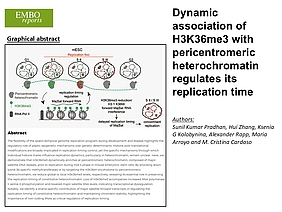New publication by the Cardoso lab on how the dynamic association of H3K36me3 with pericentromeric heterochromatin regulates its replication time
Pradhan SK, Zhang H, Kolobynina KG, Rapp A, Arroyo M, Cardoso MC (2025) Dynamic association of H3K36me3 with pericentromeric heterochromatin regulates its replication time. EMBO Rep Link
Abstract:
The flexibility of the spatio-temporal genome replication program during development and disease highlights the regulatory role of plastic epigenetic mechanisms over genetic determinants. Histone post-translational modifications are broadly implicated in replication timing control, yet the specific mechanisms through which individual histone marks influence replication dynamics, particularly in heterochromatin, remain unclear. Here, we demonstrate that H3K36me3 dynamically enriches at pericentromeric heterochromatin, composed of major satellite DNA repeats, prior to replication during mid S phase in mouse embryonic stem cells. By knocking down lysine 36-specific methyltransferases or by targeting the H3K36M oncohistone to pericentromeric heterochromatin, we reduce global or local H3K36me3 levels, respectively, revealing its essential role in preserving the replication timing of constitutive heterochromatin. Loss of H3K36me3 accompanies increased RNA polymerase II serine-5 phosphorylation and lowered major satellite RNA levels, indicating transcriptional dysregulation. Notably, we identify a strand-specific contribution of major satellite forward transcripts in regulating the replication timing of constitutive heterochromatin and maintaining chromatin stability, highlighting the importance of non-coding RNAs as critical regulators of replication timing.
Read the full paper here: https://www.embopress.org/doi/full/10.1038/s44319-025-00575-6

